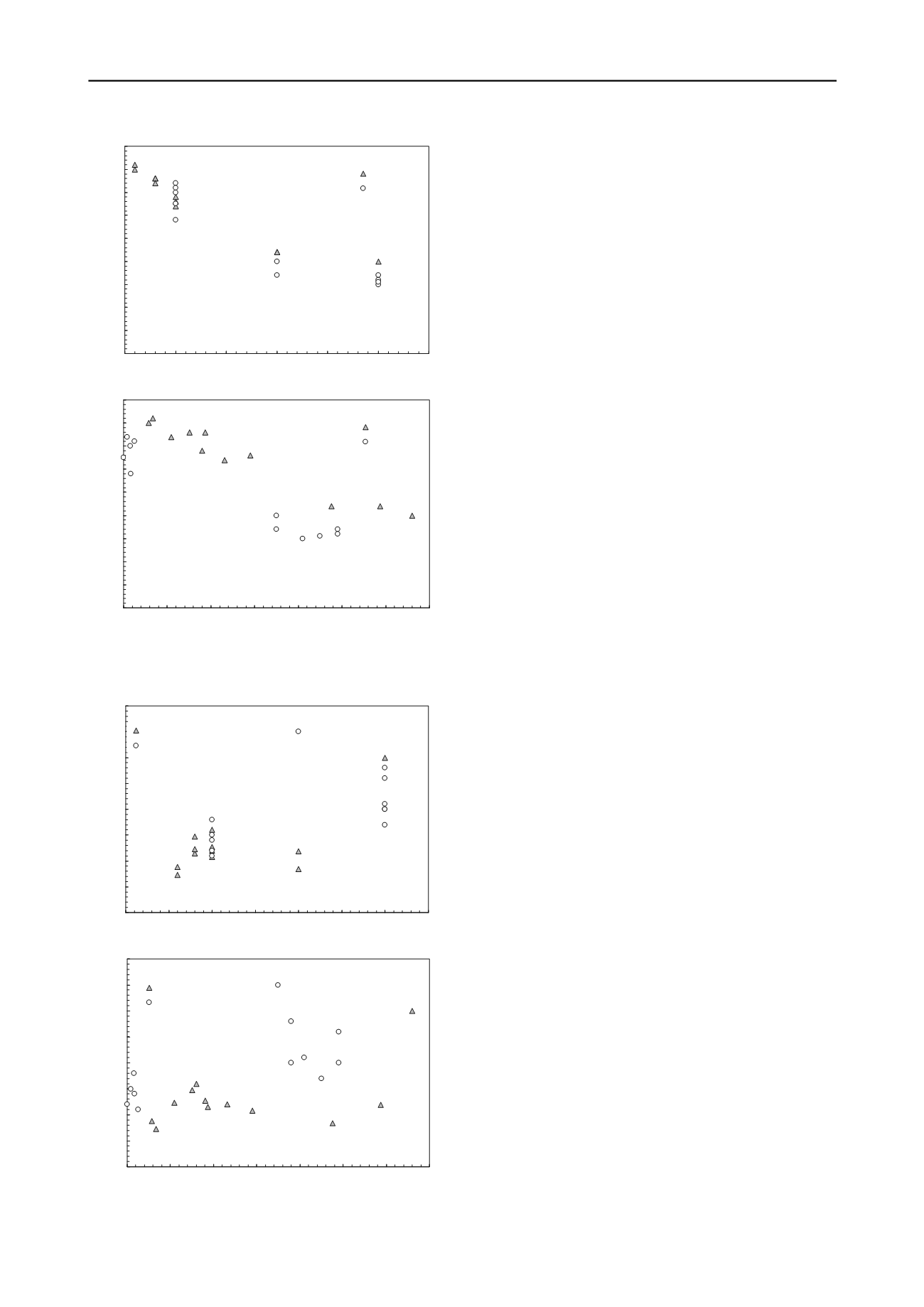
2572
Proceedings of the 18
th
International Conference on Soil Mechanics and Geotechnical Engineering, Paris 2013
0
0.5
1
1.5
2
2.5
3
3.5
4
4.5
0.5
1
1.5
2
2.5
3
3.5
Water-to-cement ratio, W/C
Shear modulus, G (GPa)
100μm - 40μm
20μm - 10μm
d
max
σ
3
= 50 kPa
γ = 10
-5
%
1.5 GPa, with increasing W/C ratio, from 0.6 to 3. The shear
modulus values of the clean sands did not exceed 170MPa,
indicating an improvement up to 25 times by grouting. The
effect of grout bleed capacity on the shear modulus of grouted
sand is clearly depicted in Figure 6, where it can be observed
that above a bleed capacity value of about 30%, the shear
modulus of the grouted sand decreases sharply by about 40%.
Cement grain size seems to have a measurable effect on the
shear modulus values of the grouted sands. For similar bleed
capacity values, the sands grouted with microfine cement grouts
have lower shear modulus values, by 15% to 30%, compared to
sands grouted with coarse-grained cement grouts.
7
DAMPING RATIO
0
0.5
1
1.5
2
2.5
3
3.5
4
4.5
0
10
20
30
40
50
60
Bleed capacity (%)
Shear modulus, G (GPa
70
)
100μm - 40μm
20μm - 10μm
d
max
σ
3
= 50 kPa
γ = 10
-5
%
Figure 6. Effect of grout W/C ratio and bleed capacity on the shear
modulus of cement grouted sands.
The damping ratio values of the grouted sands are presented in
Figure 7 for a confining pressure equal to 50kPa and shear
strain equal to 10
-3
%. The effect of shear strain and confining
pressure on the grouted sand damping ratio has been presented
elsewhere (Pantazopoulos and Atmatzidis 2012). In general, the
values obtained ranged from 0.5% to 8.0%, increased with
increasing shear rate (from 5*10
-5
% to 5*10
-2
%) and decreased
with increasing confining pressure (from 50kPa to 400kPa). The
grout W/C ratio has a measurable effect on the damping ratio
values of the grouted sands, which have a tendency to increase
with increasing W/C ratio. The effect of grout bleed capacity on
the damping ratio of the grouted sand appears to be less
dominant, mainly for coarse-grained cements. For microfine
cements there is a tendency for the damping ratio of the grouted
sands to increase with increasing bleed capacity of the grouts.
Even though the available data are limited, grouted sands
injected with stable grouts (bleed capacity less than 5%) of
microfine cements indicated damping ratios lower by 50% than
those for grouting with unstable grouts. The damping ratios of
the clean sands (for confining pressure and shear strain equal to
50kPa and 10
-3
%, respectively) did not exceed 0.5%, indicating
an improvement up to 10 times by grouting.
0
0.5
1
1.5
2
2.5
3
3.5
4
0
0.5
1
1.5
2
2.5
3
3
Water-to-cement ratio, W/C
Damping ratio, D
t
(%)
.5
100μm - 40μm
20μm - 10μm
d
max
σ
3
= 50 kPa
γ = 10
-3
%
8
CONCLUSIONS
Based on the results obtained and the observations made, the
following major conclusions may be advanced:
1. Bleed capacity is an indicator of grout effectiveness, since it
is representative of the soil void volume filled by cement.
2. The distinction between stable and unstable grouts may not
be an indicator of grout effectiveness since similar effects may
be produced by both stable and unstable grouts.
3. Bleed capacity values correlate very well with some grouted
sand properties (i.e. unconfined compression strength, cohesion)
and not at all with other properties (i.e. damping ratio, internal
friction angle) .
9
ACKNOWLEDGEMENTS
0
0.5
1
1.5
2
2.5
3
3.5
4
0
10
20
30
40
50
60
Bleed capacity (%)
Damping ratio, D
t
(%)
70
100μm - 40μm
20μm - 10μm
d
max
σ
3
= 50 kPa
γ = 10
-3
%
The information reported herein is part of research project
PENED-03ED527, co-financed by the European Social Fund
(75%) and the Greek Ministry of Development (25%).
10
REFERENCES
Pantazopoulos I.A., Markou I.N., Christodoulou D.N., Droudakis A.I.,
Atmatzidis D.K., Antiohos S.K., Chaniotakis E. 2012.
Development of microfine cement grouts by pulverizing ordinary
cements.
Cement and Concrete Composites
34, 593-603.
Head K.H. 1986.
Manual of soil laboratory testing
. vol.3. Pentech Press
Ltd, London.
Pantazopoulos I.A. and Atmatzidis D.K. 2012. Dynamic properties of
microfine cement grouted sands.
Soil Dynamics and Earthquake
Engineering
42, 17-31.
Figure 7. Effect of grout W/C ratio and bleed capacity on the damping
ratio of cement grouted sands.
Dano C., Hicher P-Y, Tailliez S. 2004. Engineering properties of
grouted sands,
Journal of Geotechnical and Geoenvironmental
Engineering
130, 328-338.


